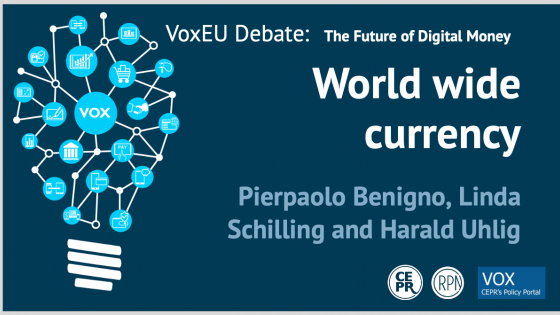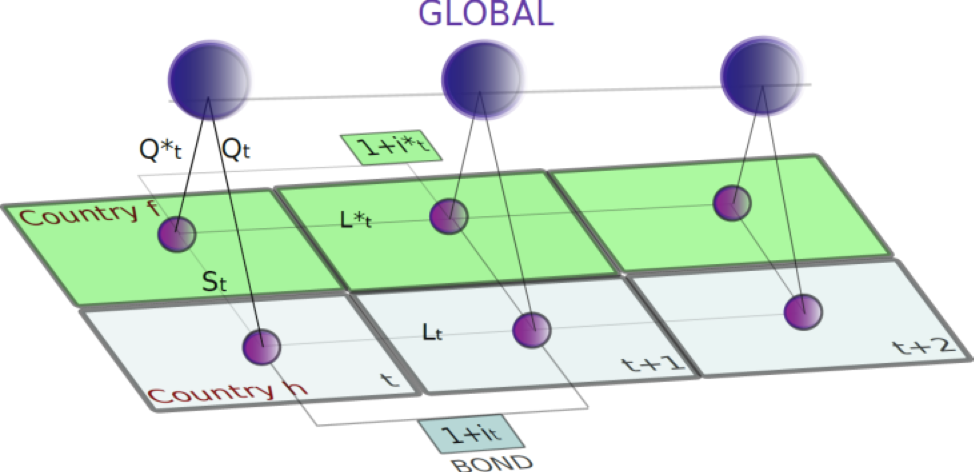This column is a lead commentary in the VoxEU Debate "The Future of Digital Money"
At the Jackson Hole conference in August 2019, the governor of the Bank of England, Mark Carney, argued that it is time to ween the world off its reliance on the US dollar and replace it with a new international monetary system. He eloquently argued that more thought should be given to creating a global electronic currency, which we call a ‘world wide currency’ (WWC), that could act as “synthetic hegemonic currency”, thus “dampen[ing] the domineering influence of the US dollar on global trade” (Financial Times 2019).
Mark Carney: be careful what you wish for! Your wish may be granted – sooner than you think and in a different manner. The rise of cryptocurrencies, starting with Bitcoin, has shown that the introduction and circulation of a WWC no longer requires a central bank – private entities can create them too. While many find fault with the design of Bitcoin and other early entries, competitive pressure has resulted in ever more attractive-looking proposals. The latest attempted entry making a considerable splash is Libra, a cryptocurrency to be issued by a Facebook-led consortium, and it surely will not be the last. We believe that we will soon have one or several well-established and much-liked privately issued global cryptocurrencies. What then are the consequences for national monetary policies? What are the consequences for exchange rates?
These are the questions that we seek to answer in a recent paper (Benigno et al. 2019). A recent literature (Benigno 2019, Fernandez-Villaverde and Sanches 2019, Garratt and Wallace 2017, Schilling and Uhlig 2019) has started to investigate the implications of competing currencies. We push the literature forward by analysing the challenges for the world economy of adopting a WWC. We envision a two-country world, where each country has its own national currency and national central bank, but where there is also a global currency in circulation. Money is special, as it is used as a means of payment and therefore provides additional liquidity services compared to, say, interest-bearing bonds. The global currency can potentially offer same liquidity services as traditional money in each national market.
Figure 1
What are the consequences of all currencies being in circulation, i.e. the national currencies in their home country, and the global currency in both? We show that this leads to what we call a ‘crypto-enforced monetary policy synchronisation’. This means that nominal interest rates set by the monetary authorities in the two countries must now be equal, and that the best forecast of the future exchange rate between the two national currencies is the current exchange rate. The monetary authorities are no longer free to pursue their own monetary policy or to set exchange rates as they please!
This result is reminiscent of the classic ‘impossible trinity’ result. According to the ‘impossible trinity’, one cannot have free capital flows, fixed exchange rates, and independent monetary policy all at the same time. But things are even tighter here: the exchange rate must be fixed or, at least, best predictable by its current value and monetary policy must be synchronised! The ‘trinity’, which is already impossible, becomes even less reconcilable.
The logic for this result can be understood most easily if we ignore uncertainty. Consider the nominal return on holding a unit of the home currency, expressed in that currency. This return is zero and below that on nominal bonds because money provides liquidity services. One can now ask: what is the nominal return on holding a unit of the global currency? One unit of the global currency today is one unit of the global currency tomorrow. So, expressed in units of the global currency, the return is zero too. But what is that return expressed in units of the home currency, given that the global currency is purchased today at the global-to-home exchange rate and sold tomorrow at that prevailing exchange rate? This return is the variation in the exchange rate between today and tomorrow. When both the global and the local currency are used at home, it means that households must be indifferent between either currency. Since the liquidity services provided are (assumed) to be the same, it then must be that the return expressed in the home currency is the same as well. It follows that the time variation in the exchange rate between the home and the global currency must be zero and therefore their exchange rate constant.
One can go through the same logic in the foreign country. And again, it follows that the exchange rate between the foreign currency and the global currency must be constant. Putting the results together, it then must be the case that the exchange rate between the home and the foreign currency is constant! With a constant exchange rate, one can then show that the nominal interest rates at home and abroad must be the same too. The two monetary policies are synchronised, enforced by that global cryptocurrency.
Are there really no choices for national monetary policies? Not really. Assume that the global currency is used abroad alongside the foreign currency. The home central bank could then seek a monetary policy, making its own currency more attractive than the global currency by preventing its adoption at home. Such a monetary policy would require setting the home nominal interest rate below that of the foreign country. While this may sound good at first, troubling implications immediately arise. The home and foreign-country central banks may both seek to free themselves of the shackles imposed by the global currency by racing towards the zero lower bound. In the end, they will both find themselves there – a situation that has plagued the major central banks throughout the world and that no one seeks to repeat.
What happens if the home country raises the nominal interest rate at home instead, while the global currency is used abroad alongside the foreign currency? In that case, the home currency becomes too expensive to use at home and only the global currency will circulate there. The home central bank effectively abolishes its own raison d’être and might enter unknown territories.
If all this already sounds rather constraining for national central banks, things become even tighter if the global cryptocurrency is issued by a private consortium against a basket of interest-bearing bonds. This is, essentially, the idea of Libra: anyone can exchange a Libra coin for the underlying bonds and vice versa, thereby fixing the exchange rate of Libra against that bond portfolio. If the consortium does not charge a management fee, its assets and liabilities should grow at the same rate, i.e. the rate of interest on the bond portfolio. This means that Libra coin should appreciate at the same rate of interest. At the end of the day, the consortium is transforming less liquid assets into very liquid money, both with the same return. The first result is that all liquidity premia will be eradicated to zero and the economy satiated in its liquidity needs. The second result is that government money, with zero return, will be completely crowded out by a Libra coin having the same liquidity value but paying a positive return. The only way out for national central banks to have their currency circulating at all is to be again stuck at the zero lower bound.
Presumably, though, the consortium will charge a management fee for the trouble of administering the bond portfolio, so then things relax a bit. But if that management fee is small, this relaxation is small too – the nominal interest rates charged in these two countries are now bound from above by that (small) fee.
One might wish to argue that such a bond-backed cryptocurrency is just a money market fund in disguise. Can’t one also convert a money market fund unit into the underlying bonds and vice versa? Where is the difference, and why has this not yet led to monetary policy synchronisation? We view the distinction as a matter of degree. Cryptocurrencies are just that – currencies. Currencies are the tokens used as a medium of exchange, while money market funds still typically need the detour of conversion into the home currency, so they might be less liquid. Moreover, it is hard to find a money market fund, which is widely used on a global scale for transaction purposes. However, the main distinction goes directly at the heart of what money is, defined by its properties: a store of value, a unit of account on top of a medium of exchange. If the consortium is successful in providing a good money, we will also likely see debt contracts being settled in Libra units and therefore further issuance of money-like securities in that currency. But this issuance is unlikely to be fully backed by safe bonds, as it is done by the consortium. Unbacked WWC will then bring to the table all the problems of controlling its value, its exchange rate, and the stability of the financial system producing the quasi-money. It seems a long way to go, but central banks and international institutions should start to think seriously about the consequences we have underlined here: low or close to zero interest rates, and losing the medium of exchange role for their currencies, or even the roles of store of value and unit of account. Regulation is an alternative, but not a straightforward one, as has been the case for commerce and information gathering over the World Wide Web. Preventing the creation of a world wide currency, or regulating it, might also be challenging.
Will Mark Carney be happy then? Perhaps, only time will tell.
References
Adrian, T and T Mancini-Griffoli (2019) “The Rise of Digital Currency”, VoxEU, 9 September.
Benigno, P (2019), "Monetary Policy in a World of Cryptocurrencies." CEPR Discussion Paper No. 13517.
Benigno, P, L Schilling and H Uhlig (2019), “Cryptocurrencies, Currency Competition and The Impossible Trinity.” CEPR Discussion Paper No. 13943.
Cecchetti, S and K Schoenholtz (2019), “Libra: A Dramatic Call to Regulatory Action,” VoxEU, 28 August.
Fatas, A and B Weder di Mauro (2019), “The Benefits of a Global Digital Currency,” VoxEU, 30 August.
Fernandez-Villaverde, J and D Sanches (2019), "Can Currency Competition Work?" Journal of Monetary Economics, forthcoming.
Financial Times (2019), “Mark Carney calls for global monetary system to replace the dollar”, 23 August.
Garratt, R and N Wallace (2017), "Bitcoin 1, Bitcoin 2, ... : An Experiment in Privately Issued Outside Monies." Unpublished manuscript, University of Santa Barbara.
Schilling, L and H Uhlig (2019), "Some Simple Bitcoin Economics." Journal of Monetary Economics, forthcoming.
Endnotes
[1] The exchange rate is a martingale.
[2] This is uncovered interest parity but in a simpler version, since currencies do not pay interest rate.
[3] Our implications follow from the extreme case, but likely to happen for a WWC, in which the two currencies are perfect substitute in all goods markets, where neither of the them dominates the other. Many developing economies have recently experienced dollarisation but not necessarily a constant dollar exchange rate, as our theory would predict. There could be several reasons that can reconcile this evidence with our theory. First, in some cases, the dollar has taken over as medium of exchange, crowding out the bad local currency plagued by inflation and depreciation. In other cases, currencies are not really substitute: the dollar is used to purchase some goods while the local currency for others. Finally, in some cases, the dollar just acts as a unit of account and not really as a means of payment.
[4] The mechanism is equivalent to a currency board, as discussed by Fatas and Weder di Mauro (2019).
[5] See also the discussion in Cecchetti and Schoenholtz (2019).
[6] Adrian and Mancini-Griffoli (2019) and Cecchetti and Schoenholtz (2019) have also expressed concerns that the sort of money-market fund set up by the consortium can break the buck, as the global financial crisis has shown. However, it is likely that this issue could be of second-order importance with respect to the spread of unbacked currency, which is going to be created out of the consortium, if Libra becomes successful.







